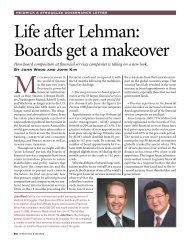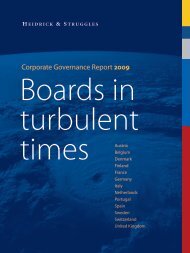A leadership game plan for sports and business - Heidrick & Struggles
A leadership game plan for sports and business - Heidrick & Struggles
A leadership game plan for sports and business - Heidrick & Struggles
Create successful ePaper yourself
Turn your PDF publications into a flip-book with our unique Google optimized e-Paper software.
A <strong>leadership</strong> <strong>game</strong><br />
<strong>plan</strong> <strong>for</strong> sport <strong>and</strong><br />
<strong>business</strong> success<br />
by Joe Bailey, Managing Partner<br />
Global Sport Leadership Advisory Group<br />
<strong>Heidrick</strong> & <strong>Struggles</strong>
Perspective<br />
In 2009, Sport as a movement was<br />
recognized as real, serious, <strong>and</strong><br />
consequential when the United Nations,<br />
under the <strong>leadership</strong> of Secretary General,<br />
Kofi Annan, granted Special Observer<br />
status to the International Olympic<br />
Committee (IOC). This meant that the<br />
IOC <strong>and</strong> all of sport was placed on the<br />
same level as institutions such as the Arab<br />
League, the Asian Development Bank,<br />
the International Red Cross, the European<br />
Union <strong>and</strong> the Vatican.<br />
“Sports is a global language<br />
capable of bridging social, cultural<br />
<strong>and</strong> religious divides. It can be<br />
a powerful tool <strong>for</strong> fostering<br />
underst<strong>and</strong>ing, tolerance <strong>and</strong><br />
peace…it teaches us teamwork <strong>and</strong><br />
fair-play. It builds self-esteem <strong>and</strong><br />
opens up new opportunities. This<br />
in turn can contribute to the wellbeing<br />
of whole communities <strong>and</strong><br />
countries.” – Kofi Annan<br />
2 A <strong>leadership</strong> <strong>game</strong> <strong>plan</strong> <strong>for</strong> sport <strong>and</strong> <strong>business</strong> success<br />
At <strong>Heidrick</strong> & <strong>Struggles</strong>, our Global Sport Leadership<br />
Advisory Practice believes that the global industry of sport<br />
needs a new caliber of <strong>leadership</strong> to match its importance<br />
on the world’s stage. Sport is a laboratory <strong>for</strong> <strong>leadership</strong><br />
<strong>and</strong> a metaphor <strong>for</strong> the belief that in any endeavor, people<br />
are the only <strong>for</strong>m of a sustainable, competitive advantage.<br />
To reach the top <strong>and</strong> stay there, the most effective leaders<br />
of the future require a broader perspective, a sense of<br />
purpose, adaptability <strong>and</strong>…wisdom.<br />
The following white paper demonstrates the power of a<br />
comprehensive human capital management program.<br />
The most effective leaders in the most admired <strong>business</strong>es<br />
spend a major portion of their time doing almost exactly<br />
what the white paper illustrates.<br />
I hope you find it to be an interesting <strong>and</strong> valuable piece.<br />
Joe Bailey<br />
Managing Partner<br />
Global Sport Leadership Advisory Group
A <strong>leadership</strong> <strong>game</strong> <strong>plan</strong> <strong>for</strong><br />
sport <strong>and</strong> <strong>business</strong> success<br />
Sports metaphors are plentiful in <strong>business</strong>.<br />
We ‘play to win;’ the CEO ‘calls the plays;’<br />
executives ‘coach’ their teams; you need<br />
to have the ‘best players’ to compete. As<br />
with any long-familiar metaphors, we<br />
stop hearing them after a while. That’s too<br />
bad, because when you strip away the<br />
analogy <strong>and</strong> look solely at the way top<br />
<strong>sports</strong> organizations actually do develop<br />
on-the-field talent you begin to get<br />
some idea of how rigorous, dem<strong>and</strong>ing,<br />
<strong>and</strong> comprehensive talent management<br />
needs to be. In non-<strong>sports</strong> <strong>business</strong>es,<br />
tangible assets like manufacturing<br />
<strong>plan</strong>ts <strong>and</strong> products can obscure the<br />
most important asset of all – talent. In<br />
<strong>sports</strong> <strong>business</strong>es, there’s no such white<br />
noise. Continual success is achieved<br />
solely through people <strong>and</strong> the focus on<br />
per<strong>for</strong>mance is relentless.<br />
The talent management approach of the US-based<br />
National Football League is a case in point. Arguably the<br />
most successful sporting body of all time, the NFL <strong>and</strong> its<br />
32 teams will generate more than $US9 billion this year<br />
with a goal of $US25 billion by 2027. Five of its teams are<br />
valued at more than $US1 billion, with another 16 nearing<br />
that figure. Only three other <strong>sports</strong> teams in the world<br />
are valued at more than US$1 billion: baseball’s New<br />
York Yankees, <strong>and</strong> soccer’s Manchester United <strong>and</strong> Real<br />
Madrid. NFL teams <strong>and</strong> similar high-per<strong>for</strong>mance <strong>sports</strong><br />
organizations focus relentlessly on talent – constantly<br />
evaluating, recruiting, developing, <strong>and</strong> onboarding players<br />
<strong>and</strong> developing their successors.<br />
In fact, the NFL’s approach to talent management, in its<br />
structure <strong>and</strong> its detail, maps closely to the approach that<br />
we apply in our <strong>leadership</strong> advisory services (figure 1). By<br />
taking a close look at the NFL’s management of talent in<br />
the context of our best-practices approach, as we do here,<br />
you can:<br />
• Benchmark the comprehensiveness <strong>and</strong> quality of your<br />
talent management program against one of the most<br />
rigorous in the world.<br />
• Bring new life to the concepts of competition through<br />
talent in your organization.<br />
• Determine what aspects of talent management in your<br />
organization need attention now.<br />
• Underst<strong>and</strong> the contours of a long-term commitment<br />
to talent management.<br />
<strong>Heidrick</strong> & <strong>Struggles</strong> 3
Ongoing Talent Strategy<br />
Development <strong>and</strong><br />
Assessment<br />
What the NFL does<br />
• SWOT (strength,<br />
weakness, opportunity<br />
<strong>and</strong> threats) analysis of<br />
talent pool<br />
• Bench assessment<br />
against overall strategy<br />
• Competitive analysis<br />
figure 1<br />
Strategy <strong>and</strong> Tactics <strong>for</strong><br />
Recruiting<br />
• Scouting “<strong>game</strong> maker”<br />
prospects<br />
• Competitive review<br />
• Benchmarking<br />
• Evaluating talent <strong>and</strong><br />
character<br />
• Testing, interviewing<br />
• Assessing fit with team<br />
<strong>and</strong> culture<br />
• Correct compensation<br />
Onboarding, Coaching,<br />
Mentoring <strong>and</strong> Retaining<br />
• Full immersion in<br />
organization’s culture<br />
<strong>and</strong> protocols<br />
• Practice<br />
• Training/Classes/<br />
Testing<br />
• One-on-one coaching<br />
• Mentoring by<br />
experienced players<br />
• Career <strong>and</strong> life<br />
counseling<br />
The NFL’s approach to talent management, in its structure <strong>and</strong> its detail, maps closely<br />
to the approach that <strong>Heidrick</strong> & <strong>Struggles</strong> applies in our <strong>leadership</strong> advisory services<br />
Leadership Development,<br />
Succession Planning,<br />
Team Building<br />
• Recognition systems<br />
• Leadership<br />
opportunities<br />
• Mentoring on<br />
<strong>leadership</strong> skills<br />
• Counseling on position<br />
opportunities<br />
• Advancements<br />
What <strong>Heidrick</strong> & <strong>Struggles</strong> Leadership Advisory does to help clients<br />
• Assesses management<br />
• Works to align strategy<br />
<strong>and</strong> organizational<br />
structure<br />
• Identifying the right<br />
talent<br />
• Recruiting <strong>and</strong> hiring<br />
• Creating a balanced,<br />
diverse work<strong>for</strong>ce with<br />
leaders who reflect<br />
such diversity<br />
Questions <strong>Heidrick</strong> & <strong>Struggles</strong> asks<br />
• Do you know what<br />
your strengths <strong>and</strong><br />
gaps are?<br />
• Do you know your<br />
competition?<br />
• Do you know what you<br />
really need to execute<br />
your strategy to avoid<br />
being an “also ran”?<br />
• Do you know where to<br />
find external <strong>leadership</strong><br />
talent?<br />
• Do you have a<br />
systematic approach<br />
to targeting <strong>and</strong><br />
attracting these<br />
people?<br />
• Do you consider<br />
character <strong>and</strong><br />
competitiveness?<br />
4 A <strong>leadership</strong> <strong>game</strong> <strong>plan</strong> <strong>for</strong> sport <strong>and</strong> <strong>business</strong> success<br />
• Integrating <strong>and</strong> onboarding<br />
• Executive coaching<br />
• Continuous learning<br />
<strong>and</strong> development<br />
• Engaging <strong>and</strong> retaining<br />
• Managing per<strong>for</strong>mance<br />
• Do you have a<br />
systematic way of<br />
integrating your<br />
new talent into your<br />
organization’s culture?<br />
• Do you have the<br />
agility to adjust as the<br />
circumstances around<br />
your strategy change<br />
subtly or dramatically?<br />
• Evaluates <strong>leadership</strong><br />
pipeline<br />
• Helps manage top-level<br />
succession<br />
• Promotion <strong>and</strong> rotation<br />
• Transitioning<br />
• Do you have a<br />
process of continuing<br />
development <strong>for</strong> your<br />
leaders?<br />
• Do you have the<br />
focus required to<br />
continuously align your<br />
<strong>leadership</strong> pipeline <strong>for</strong><br />
the future?
Ironically, many <strong>sports</strong> organizations can benefit as well,<br />
because we’ve often found that they neglect to bring into<br />
the front office the same relentless emphasis on talent<br />
management <strong>and</strong> <strong>leadership</strong> that they employ on the<br />
field. For <strong>sports</strong> <strong>and</strong> non-<strong>sports</strong> <strong>business</strong>es alike, needing<br />
to have the best players in the executive suite is no<br />
metaphor – it’s a condition <strong>for</strong> winning.<br />
The constant:<br />
continuous evaluation<br />
The difference between the assessment of talent in <strong>sports</strong><br />
versus non-<strong>sports</strong> organizations lies in the relentlessness<br />
of the scrutiny. Chief executives in <strong>business</strong> usually face<br />
the analysts <strong>and</strong> the media only once a quarter, with the<br />
focus mainly on the bottom-line results. But in sport,<br />
managers <strong>and</strong> coaches are locked into a 24/7 cycle of<br />
scrutiny with strategy <strong>and</strong> tactics <strong>and</strong> daily per<strong>for</strong>mance<br />
under the spotlight from expert <strong>and</strong> armchair critic alike.<br />
Managers, coaches <strong>and</strong> players must learn to be articulate,<br />
to explain not only the result but how it was achieved,<br />
<strong>and</strong> to maintain patience <strong>and</strong> agility in the face of intense<br />
<strong>and</strong> sometimes insulting questioning. They must have<br />
not only athletic prowess <strong>and</strong> knowledge, but a powerful<br />
combination of talent, character, <strong>and</strong> intelligence – along<br />
with the ability to deliver results – that is required of top<br />
per<strong>for</strong>mers in any organization.<br />
In the <strong>sports</strong> world, where the product is human, there<br />
is no place <strong>for</strong> the semi-annual per<strong>for</strong>mance review.<br />
Instead, daily critique <strong>and</strong> feedback are required to<br />
fine-tune the team’s ability to beat the competition. No<br />
matter what the experience level of any given player,<br />
their skills, knowledge, <strong>and</strong> talent <strong>and</strong> motivations<br />
scrutinized constantly <strong>and</strong> evaluated in terms of individual<br />
per<strong>for</strong>mance, team dynamic <strong>and</strong> <strong>leadership</strong> potential.<br />
In this process of continual evaluation, the NFL team<br />
considers factors that are critical to the success of all highper<strong>for</strong>mance<br />
organizations, <strong>sports</strong> <strong>and</strong> non-<strong>sports</strong> alike,<br />
including:<br />
• Underst<strong>and</strong>ing each player’s present capabilities<br />
<strong>and</strong> predicting future per<strong>for</strong>mance. Given the time,<br />
money <strong>and</strong> development ef<strong>for</strong>t that will be invested<br />
to maximize the individual’s talent, it is essential to<br />
accurately assess potential.<br />
• Recognizing when a player begins to descend rather<br />
than ascend. This requires constant review, with the<br />
underst<strong>and</strong>ing that in terms of effectiveness <strong>and</strong> costs<br />
there is a trade-off between ability <strong>and</strong> experience.<br />
• Putting the right combination of people together to<br />
<strong>for</strong>m an effective unit. The unit must be capable of<br />
executing team strategies; <strong>and</strong> the unit, as well as the<br />
individuals in it, must be able to adjust based on short<br />
<strong>and</strong> longer term competitive challenges.<br />
In the course of evaluation, leaders must make difficult<br />
personnel decisions. In the NFL that means the head<br />
coaches, assistant head coaches, coordinators, position<br />
coaches <strong>and</strong> general managers. In non-<strong>sports</strong> <strong>business</strong>es it<br />
means the C-level executives, <strong>business</strong> unit <strong>and</strong> functional<br />
leaders, <strong>and</strong> managers. In both environments, leaders<br />
must not only make judgments but also mentor, guide,<br />
support, teach, <strong>and</strong> encourage those who report to them,<br />
while grooming successors or hiring higher-potential<br />
talent from the outside who will eventually take the place<br />
of some of the current talent.<br />
“In the <strong>sports</strong> world,<br />
where the product is<br />
human, there is no place<br />
<strong>for</strong> the semi-annual<br />
per<strong>for</strong>mance review.”<br />
<strong>Heidrick</strong> & <strong>Struggles</strong> 5
Because the team dynamic is every bit as important as the<br />
talents of the individual, much time should be devoted<br />
to assessing how the individual impacts the whole <strong>and</strong><br />
how the team contributes to an individual’s per<strong>for</strong>mance.<br />
In addressing this question, NFL coaches, like the best<br />
<strong>business</strong> executives, employ some basic tenets of building<br />
<strong>and</strong> maintaining teams:<br />
• People are the only real <strong>for</strong>m of a sustainable<br />
competitive advantage.<br />
• Players love to have teammates who contribute to the<br />
success of the whole.<br />
• Successful coaches want to develop players <strong>and</strong> give<br />
them the peace of mind that comes with knowing that<br />
they have become the best they can be, particularly<br />
when their best is needed.<br />
• Each player is unique <strong>and</strong> must be understood in terms<br />
of his individual motivation <strong>and</strong> how he learns, thinks,<br />
<strong>and</strong> makes decisions.<br />
Special attention is devoted to motivation because it<br />
speaks to both competitiveness <strong>and</strong> character, two of the<br />
most critical factors in sport <strong>and</strong> in <strong>business</strong>. In terms of<br />
competiveness, how badly does the player want to win?<br />
Is he a clutch player? Is he determined to be the best? Is<br />
he aggressive, tough? Does he have the temperament of<br />
a winner? Does he like to practice <strong>and</strong> prepare? In terms<br />
of character, is he coachable? Is he a bad actor? Does he<br />
show <strong>leadership</strong> qualities? Does he enjoy the <strong>game</strong>? Is<br />
he a quitter? Does he have good training habits? Is he<br />
curious? What kind of personality does he have? Those<br />
are, in effect, the same probing behavioral questions,<br />
couched somewhat differently, we seek to answer when<br />
evaluating a c<strong>and</strong>idate or assessing an incumbent<br />
executive <strong>for</strong> a client. Often miscalled the ‘soft’ stuff, these<br />
traits, as coaches know, need as hardheaded assessment<br />
as physical traits.<br />
6 A <strong>leadership</strong> <strong>game</strong> <strong>plan</strong> <strong>for</strong> sport <strong>and</strong> <strong>business</strong> success<br />
Finally, with every team, <strong>leadership</strong> is critical. No two<br />
leaders look the same. They come in all shapes, sizes,<br />
colors, age <strong>and</strong> genders. What they do have in common is:<br />
• A relentless work ethic driven by passion <strong>for</strong> the<br />
content of what they do.<br />
• A vision of where they wish to go <strong>and</strong> the ability to<br />
communicate <strong>and</strong> persuade people internally <strong>and</strong><br />
externally to follow.<br />
• The self-confidence to surround themselves with<br />
the best people, including those who may be more<br />
talented than they are.<br />
• The perspective that their <strong>leadership</strong> position is a<br />
privilege to hold <strong>and</strong> an opportunity to serve, not a<br />
permanent right.<br />
• An unquestioned integrity <strong>and</strong> trustworthiness<br />
at all times.<br />
‘Mis<strong>leadership</strong>’ occurs when a leader’s vision is unethical<br />
or misguided. In sport, ‘mis<strong>leadership</strong>’ can occur over the<br />
breaking of rules, player abuse, safety, <strong>and</strong> bad decisionmaking<br />
or judgment involving personnel evaluations<br />
<strong>and</strong> player relations. Over a period of time, poor team<br />
per<strong>for</strong>mance is apparent to all. Usually, the head coach<br />
is then replaced, the philosophy revised <strong>and</strong> the needs<br />
assessment updated to support the new philosophy.<br />
Throughout it all, the process of evaluation continues<br />
without letup.<br />
“Motivation speaks to<br />
both competitiveness<br />
<strong>and</strong> character, two of the<br />
most critical factors in<br />
sport <strong>and</strong> in <strong>business</strong>.”
The cycle of<br />
ongoing evaluation<br />
Scouting <strong>and</strong> recruiting talent<br />
NFL teams’ sophisticated player evaluation process begins<br />
with the extensive scouting <strong>for</strong> talent, much as we monitor<br />
executive talent around the world. Initially, players are<br />
divided into two groups – amateur (college, junior college,<br />
no college) <strong>and</strong> professional (NFL, Canadian Football<br />
League, Arena Football League). Most of the amateurs in<br />
the pool come from US colleges. Each year, roughly 1800<br />
players are considered ‘suspects’ <strong>for</strong> NFL consideration.<br />
Through an elaborate screening process, about 350<br />
players are deemed ‘prospects’ <strong>for</strong> entry into the NFL. The<br />
evaluation process <strong>for</strong> the ‘Top 350’ is done by the college<br />
scouting departments. Each team has a college scouting<br />
department. The list of the top 350 <strong>for</strong> each team may vary,<br />
depending on the team’s criteria. The better departments<br />
are philosophically consistent about basics, work with the<br />
same coaching staffs <strong>and</strong> management <strong>for</strong> years, <strong>and</strong> seek<br />
to continually improve.<br />
Players are scouted up to three years prior to their<br />
eligibility to enter the NFL draft. In addition, taped <strong>game</strong><br />
per<strong>for</strong>mance is evaluated by experts <strong>and</strong> practices are<br />
observed. References are taken from trainers, position<br />
coaches, head coaches, strength coaches, <strong>sports</strong><br />
in<strong>for</strong>mation directors, professors, athletic directors,<br />
doctors, teammates, high school coaches, friends, parents.<br />
Psychological <strong>and</strong> intelligence tests are also administered.<br />
All reports are part of a player profile, which is entered<br />
into a database of grades calculated according to the<br />
scouting department’s proprietary weightings of the<br />
desired attributes. Players are automatically compared<br />
<strong>and</strong> contrasted based on present team members, existing<br />
players in the NFL, <strong>and</strong> against others at their position, just<br />
as we benchmark executives against internal <strong>and</strong> external<br />
talent so that clients underst<strong>and</strong> what the possibilities are.<br />
Additionally, teams belong to scouting groups made<br />
up of as many as 15 teams. These groups independently<br />
write reports <strong>and</strong> per<strong>for</strong>m additional evaluation. Both<br />
teams <strong>and</strong> groups conduct personal interviews with<br />
players during the course of their college careers. Crosschecking<br />
is important to confirm or find gaps in consistent<br />
measurables, leading up to what is known as the ‘combine’<br />
process. The ‘combine’ is run under the auspices of the<br />
league <strong>and</strong> held approximately three months be<strong>for</strong>e<br />
the draft. All head coaches, many assistant coaches, <strong>and</strong><br />
staff from all teams attend. Based on the position they<br />
play, players are timed <strong>for</strong> speed, diagnostically tested,<br />
weighed, measured, given strength <strong>and</strong> agility tests, <strong>and</strong><br />
put through individual drills by coaches.<br />
Players are required to be interviewed about their<br />
knowledge of the <strong>game</strong> <strong>and</strong> the position they play, the<br />
system <strong>and</strong> techniques they have been schooled in, <strong>and</strong><br />
relevant personal background. Medical examinations<br />
have taken on great importance <strong>and</strong> every doctor, trainer,<br />
head of player personnel, <strong>and</strong> head coach sees full reports<br />
on every player. Everyone who has contact with the<br />
player grades him based on carefully selected criteria.<br />
In<strong>for</strong>mation is shared at the combine, but teams keep their<br />
evaluations confidential. The ‘combine’ workouts are even<br />
televised over a 4-5 day period <strong>and</strong> personnel back at team<br />
headquarters also grade the workouts.<br />
What order a player is taken in the draft determines<br />
compensation over the first 3-4 years of his professional<br />
life, if he makes the team <strong>and</strong> stays on it. There<strong>for</strong>e,<br />
evaluators are important because they determine<br />
the initial cost versus the impact of the player to the<br />
team, both <strong>for</strong> the short <strong>and</strong> long term. Evaluators are<br />
themselves evaluated by their employers. Depending<br />
upon the accuracy of their evaluations, judged over a<br />
3-5 year period, they retain their jobs or they are<br />
managed out.<br />
Normally, contracts are negotiated by an expert<br />
negotiator, operating under the constraints of the league<br />
salary cap <strong>and</strong> the team’s philosophy about player<br />
compensation design <strong>and</strong> budgeting. Today, nearly all<br />
players are represented by player agents, who negotiate<br />
contracts on their behalf. Every agent wants a base salary<br />
<strong>for</strong> the player/client plus ‘incentive’ clauses – player<br />
per<strong>for</strong>mance, unit per<strong>for</strong>mance, team per<strong>for</strong>mance, team<br />
success. Signing bonuses are very large <strong>for</strong> players drafted<br />
earliest. Usually, the only guaranteed money is <strong>for</strong> signing,<br />
reporting, <strong>and</strong> making the squad. Once a player signs, he<br />
becomes a professional.<br />
<strong>Heidrick</strong> & <strong>Struggles</strong> 7
“Considerable skill is required to elicit the critical<br />
concerns that are weighing on the minds of<br />
highly desirable per<strong>for</strong>mers.”<br />
But it is with free agents, especially proven stars who<br />
may be sought after by many teams, that the relation<br />
of compensation to recruiting most resembles that of<br />
non-<strong>sports</strong> <strong>business</strong>es. In both worlds, winning the<br />
competition <strong>for</strong> top per<strong>for</strong>mers is not simply a matter<br />
of money. They will consider personal issues like their<br />
preferred location <strong>and</strong> the needs of their families. And they<br />
will consider professional issues like their opportunities<br />
to contribute, the likelihood of the organization’s success,<br />
<strong>and</strong> the quality of the other team members. In both<br />
settings, considerable skill is often required to elicit the<br />
critical concerns that are weighing on the minds of these<br />
highly desirable per<strong>for</strong>mers. In our work helping clients<br />
consummate the recruiting process with outst<strong>and</strong>ing<br />
c<strong>and</strong>idates, we have found that c<strong>and</strong>idates may not have<br />
clearly articulated to themselves precisely what some of<br />
those concerns are, but through skillful interviewing <strong>and</strong><br />
<strong>for</strong>mal <strong>and</strong> in<strong>for</strong>mal interaction we are able to get those<br />
issues on the table <strong>and</strong> address them. In these highly<br />
competitive recruiting situations, it is the sensitivity <strong>and</strong><br />
comprehensiveness with which those issues are treated<br />
that can be the tipping point in the c<strong>and</strong>idate’s ultimate<br />
decision.<br />
Onboarding, coaching,<br />
<strong>and</strong> team building<br />
Once signed, players become the responsibility of the<br />
head coach <strong>and</strong> the coaching staff. The average coach to<br />
player ratio is one coach <strong>for</strong> every 2-3 players the coach has<br />
to develop. Players go through team orientation, a league<br />
‘rookie’ orientation, <strong>and</strong> rigorous, organized off-season<br />
conditioning, training <strong>and</strong> skills programs be<strong>for</strong>e the team<br />
training camp begins. Initially, rookies compete with other<br />
rookies who play the same positions. When training camp<br />
begins they then compete with veteran players.<br />
8 A <strong>leadership</strong> <strong>game</strong> <strong>plan</strong> <strong>for</strong> sport <strong>and</strong> <strong>business</strong> success<br />
The approximately seven-week training camp is about<br />
evenly divided between classroom <strong>and</strong> work on the field.<br />
Later in camp, contact scrimmages are conducted <strong>and</strong><br />
then pre-season <strong>game</strong>s (friendlies) take place against<br />
other teams. During this period, many players, both<br />
rookies <strong>and</strong> veterans, are dropped from the team. Be<strong>for</strong>e<br />
the first regular season <strong>game</strong>, the team is finally winnowed<br />
down from 80 members to 53. Forty-seven are in uni<strong>for</strong>m<br />
<strong>for</strong> every regular <strong>game</strong>, there are eight additional players<br />
on the practice squad.<br />
Throughout the process, players are graded every day in<br />
the classroom with verbal <strong>and</strong> written quizzes <strong>and</strong> on the<br />
field. Field work includes ‘walk-throughs’ of plays, group<br />
drills, <strong>and</strong> scrimmages, all of which are videotaped. Every<br />
player receives instant feedback. On-field coaches write<br />
reports that are discussed in daily coaching staff meetings.<br />
Players are benchmarked against others they are<br />
competing against at their position, ranked internally <strong>and</strong><br />
listed on external ‘depth charts.’ Players always know where<br />
they st<strong>and</strong> compared to others. Some players quit, some<br />
get injured, others get shifted to other positions where<br />
they have to learn an entirely new set of rules, techniques,<br />
<strong>and</strong> skills. It is a ruthless meritocracy that is both mentally<br />
<strong>and</strong> physically dem<strong>and</strong>ing <strong>for</strong> all players every year.<br />
Character <strong>and</strong> motivation are constantly evaluated as is<br />
improvement through classroom <strong>and</strong> field repetition. The<br />
regular season is an endurance contest where players,<br />
units <strong>and</strong> teams must continually improve individual<br />
<strong>and</strong> team per<strong>for</strong>mance. Coaches teach techniques <strong>and</strong><br />
systems. They try to determine the capabilities of their<br />
players <strong>and</strong> then judge to what degree their systems <strong>and</strong><br />
the players within the schemes can be best utilized. As<br />
players become more familiar with the techniques <strong>and</strong><br />
schemes, they become second nature. Systems are learned<br />
<strong>and</strong> confidence grows, individually <strong>and</strong> collectively,<br />
among teammates <strong>and</strong> coaches. Players who have
een competing against each other ultimately become<br />
teammates <strong>and</strong> colleagues as a result of the confluence<br />
of their character <strong>and</strong> the <strong>leadership</strong> of coaches. A team<br />
‘personality’ or culture is established. The same dynamic<br />
occurs in the corporate world, where highly competitive<br />
executives must be welded into a cohesive team by skillful<br />
leaders.<br />
Once training camp begins, the team’s pro personnel<br />
department has responsibility <strong>for</strong> monitoring individual,<br />
unit, <strong>and</strong> team productivity through ‘quality control.’<br />
Are the individuals, units, <strong>and</strong> divisions meeting the<br />
organization’s pre-determined <strong>and</strong> attainable per<strong>for</strong>mance<br />
goals? Additionally, the pro personnel department is<br />
grading players around the league, <strong>for</strong>ce ranking them<br />
<strong>for</strong> possible trade value. They are also helping the head<br />
coach develop a <strong>game</strong> <strong>plan</strong> <strong>for</strong> each week by scouting<br />
opponents, <strong>and</strong> they may also grade <strong>game</strong> officials. Each<br />
week during the season, free agents are brought in <strong>for</strong><br />
tryouts, adding to the constant evaluation process.<br />
The department also works with the position coaches <strong>for</strong><br />
the exit interview which every player undergoes at the end<br />
of the season. The interview is a complete review of the<br />
year <strong>for</strong> that player, not unlike per<strong>for</strong>mance reviews in the<br />
corporate world, where strengths, weaknesses, <strong>and</strong> areas<br />
<strong>for</strong> improvement are discussed. The player will be given a<br />
complete off-season regime, which includes conditioning<br />
<strong>and</strong> drills <strong>for</strong> improving skills, much as executives are given<br />
development <strong>plan</strong>s.<br />
During the two-month off-season, coaches are available<br />
as well as support staff <strong>for</strong> help <strong>and</strong> guidance. Players<br />
have counselors <strong>for</strong> special issues <strong>and</strong> to the extent<br />
possible are monitored <strong>and</strong> checked with weekly. And, of<br />
course, during the off-season, the coaching staff is doing<br />
a complete needs assessment, fine tuning the operating<br />
strategy <strong>and</strong> preparing to repeat the cycle. As in <strong>business</strong>,<br />
the evaluation process has no off-season.<br />
Leadership issues <strong>and</strong> roles<br />
High-per<strong>for</strong>mance teams often appear to be totally<br />
cohesive externally but in fact are conflicted internally.<br />
Team dynamics are constantly managed by focusing on<br />
the productivity of the player, the unit, <strong>and</strong> the team.<br />
The head coach sets the vision <strong>and</strong> the assistant coaches<br />
are the managers responsible <strong>for</strong> the per<strong>for</strong>mance of the<br />
individual, the units <strong>and</strong> the team.<br />
Like a CEO the head coach deals with fiscal assets,<br />
marketing, financial issues, productivity, innovations,<br />
social responsibility, profitability (as measured by the<br />
competitiveness of the team), but spends most of his<br />
time on human asset objectives, strategy, <strong>and</strong> tactics. His<br />
assistant coaches, as many as 24, are the managers he<br />
must lead, along with the players. While all head coaches<br />
have their own styles, the successful ones all have the<br />
characteristics of the classic effective leader.<br />
Players are expected to develop <strong>and</strong> show continued<br />
improvement both on <strong>and</strong> off the field. Players who fail<br />
typically do so at the beginning or within three years. After<br />
three years, the organization’s confidence in the player<br />
grows <strong>and</strong> he is deemed ascending, mature, or descending<br />
in various areas. Judging each player’s status determines<br />
off-season strategies about re-signing players, signing free<br />
agents, drafting <strong>for</strong> need, succession at various positions,<br />
<strong>and</strong> <strong>leadership</strong>.<br />
The head coach appoints player captains, who are usually<br />
highly respected in the locker room. They may lead in<br />
productivity or by position, but above all they believe<br />
in the head coach, his system, <strong>and</strong> his vision. They trust<br />
the head coach <strong>and</strong> their reputations enable them to<br />
influence the other players. They are good listeners, acting<br />
as counselors to players, <strong>and</strong> bring issues, large <strong>and</strong> small,<br />
to the attention of the head coach.<br />
Coaches – <strong>and</strong> CEOs – must be especially adept at<br />
h<strong>and</strong>ling stars, who can be problematic people <strong>and</strong> create<br />
internal issues. As the saying goes, “anyone can h<strong>and</strong>le<br />
jackasses; it’s hard to h<strong>and</strong>le thoroughbreds.” Most players<br />
recognize that blue chip players – the real <strong>game</strong> changers<br />
– make everyone better. They may not be especially liked<br />
but they are appreciated <strong>for</strong> what they do. Teams believe<br />
that the more quality players, the better chance the team<br />
has to per<strong>for</strong>m well against the best competition. So do<br />
companies, <strong>and</strong> those that succeed have learned not only<br />
how to evaluate, attract, <strong>and</strong> keep top talent, but also how<br />
to integrate that talent with the team <strong>and</strong> the objectives of<br />
the organization.<br />
<strong>Heidrick</strong> & <strong>Struggles</strong> 9
figure 2<br />
<strong>Heidrick</strong> & <strong>Struggles</strong>’ Leadership Talent Cycle<br />
10 A <strong>leadership</strong> <strong>game</strong> <strong>plan</strong> <strong>for</strong> sport <strong>and</strong> <strong>business</strong> success
Managing your<br />
<strong>leadership</strong><br />
talent cycle<br />
Effective leaders value talent. Yet in today’s competitive<br />
<strong>and</strong> fast-moving market, good leaders too often<br />
concentrate on the near-term urgencies of doing <strong>business</strong><br />
<strong>and</strong> neglect the dem<strong>and</strong>ing task of inculcating in their<br />
organization a culture that nurtures talent. The talent<br />
management practices of NFL teams provide a vivid lesson<br />
in that regard. Few competitive situations seem more<br />
short-term than the battle with a different opponent an<br />
NFL team faces from week to week. Yet, the teams know<br />
that to win those short-term battles they must make a<br />
long-term commitment to talent management <strong>and</strong> make<br />
the evaluation <strong>and</strong> development of players a continual,<br />
rigorous, <strong>and</strong> comprehensive process that is perhaps<br />
unequalled anywhere outside of <strong>sports</strong>.<br />
While the professional <strong>sports</strong> environment is in many<br />
ways unique, many elements of the approach to talent<br />
management that high-per<strong>for</strong>mance <strong>sports</strong> organizations<br />
take can be found in non-<strong>sports</strong> approaches. For example,<br />
our ‘Leadership Talent Cycle’ (figure 2), developed <strong>for</strong><br />
<strong>business</strong> clients by our Leadership Advisory services, helps<br />
clients address:<br />
• The importance of aligning a talent strategy with the<br />
<strong>business</strong> strategy.<br />
• The value of good judgment, experience, emotional<br />
intelligence, <strong>and</strong> rigorous processes.<br />
• The disciplines of continual evaluation.<br />
• The “feel” to balance continuity with small <strong>and</strong><br />
profound change.<br />
• The assessment of team members <strong>and</strong> team dynamics.<br />
• The importance of developing leaders.<br />
As with any process, some organizations are better at<br />
talent management than others. Some that are good<br />
at it may see their ability erode <strong>and</strong> find themselves<br />
surpassed by newly adept organizations, just as the<br />
<strong>for</strong>tunes of companies may rise <strong>and</strong> fall <strong>and</strong> rise again<br />
over the long term based not just on <strong>business</strong> conditions<br />
but on the talent they are able to identify, recruit, <strong>and</strong><br />
develop. The investment in a comprehensive human<br />
capital management program must be viewed not as a<br />
short-term solution, but as a long-term investment in an<br />
organization’s ability to thrive throughout various <strong>business</strong><br />
cycles. And with the assistance of professionals whose sole<br />
<strong>business</strong> is talent management, there is no reason that an<br />
organization can’t be at the top of its <strong>game</strong> when it comes<br />
to people. Technology, strategy, competitiveness, market<br />
<strong>leadership</strong> – those things that many leaders focus on to<br />
be successful – are all driven by people. There is no more<br />
pressing priority, whether in <strong>business</strong>, government, NGOs,<br />
or the NFL. <br />
About the Global<br />
Sport Leadership<br />
Advisory Group<br />
The Global Sport Leadership Advisory Group of <strong>Heidrick</strong><br />
& <strong>Struggles</strong> helps solve complex talent issues <strong>for</strong><br />
organizations involved in the <strong>sports</strong> ecosystem. Our global<br />
team serves content providers; distribution channels,<br />
including media <strong>and</strong> facilities; <strong>and</strong> solution providers from<br />
healthcare providers <strong>and</strong> sporting goods manufacturers<br />
to construction <strong>and</strong> food <strong>and</strong> beverage suppliers. Our<br />
capabilities include executive <strong>leadership</strong> searches <strong>for</strong><br />
commissioners, owners, chairmen, board members, head<br />
coaches <strong>and</strong> managers; <strong>and</strong> in concert with our highly<br />
experienced <strong>leadership</strong> consultants, we also provide<br />
assessment, team effectiveness consulting <strong>and</strong> succession<br />
<strong>plan</strong>ning services.<br />
<strong>Heidrick</strong> & <strong>Struggles</strong> 11
<strong>Heidrick</strong> & <strong>Struggles</strong> is the <strong>leadership</strong> advisory firm<br />
providing senior-level executive search <strong>and</strong> <strong>leadership</strong><br />
consulting services. For almost 60 years, we have been<br />
building deep relationships with the world’s most<br />
talented individuals on behalf of the world’s most<br />
successful companies. Through the strategic acquisition,<br />
development, <strong>and</strong> retention of talent we help our clients<br />
– from the most established market giants to the newest<br />
market disruptors – build winning <strong>leadership</strong> teams.<br />
www.heidrick.com<br />
Copyright ©2010 <strong>Heidrick</strong> & <strong>Struggles</strong> International, Inc.<br />
All rights reserved. Reproduction without permission is prohibited.<br />
Trademarks <strong>and</strong> logos are copyrights of their respective owners.<br />
201001JNTSRG48

















